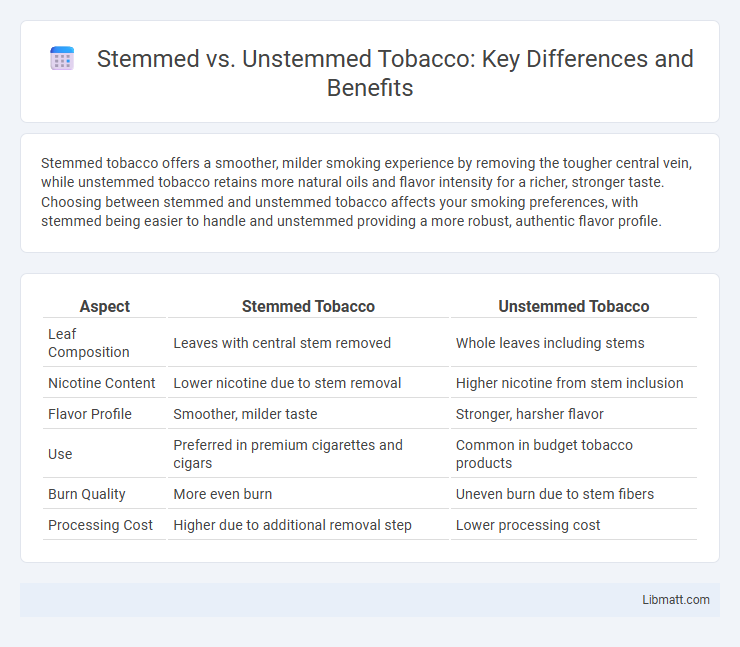Stemmed tobacco offers a smoother, milder smoking experience by removing the tougher central vein, while unstemmed tobacco retains more natural oils and flavor intensity for a richer, stronger taste. Choosing between stemmed and unstemmed tobacco affects your smoking preferences, with stemmed being easier to handle and unstemmed providing a more robust, authentic flavor profile.
Table of Comparison
| Aspect | Stemmed Tobacco | Unstemmed Tobacco |
|---|---|---|
| Leaf Composition | Leaves with central stem removed | Whole leaves including stems |
| Nicotine Content | Lower nicotine due to stem removal | Higher nicotine from stem inclusion |
| Flavor Profile | Smoother, milder taste | Stronger, harsher flavor |
| Use | Preferred in premium cigarettes and cigars | Common in budget tobacco products |
| Burn Quality | More even burn | Uneven burn due to stem fibers |
| Processing Cost | Higher due to additional removal step | Lower processing cost |
Introduction to Stemmed and Unstemmed Tobacco
Stemmed tobacco contains removed stems, resulting in a smoother flavor and easier burning experience, while unstemmed tobacco includes the entire leaf for a stronger, more robust taste. Your choice between stemmed and unstemmed tobacco influences the intensity and texture of the smoke, with stemmed offering milder notes and unstemmed providing richer, leafier characteristics. Understanding these differences helps tailor your tobacco use to preferred flavor profiles and smoking styles.
Defining Stemmed Tobacco
Stemmed tobacco refers to tobacco leaves that have had their central stems removed, resulting in a smoother texture and more consistent burn quality. This processing technique reduces harshness and enhances the flavor profile of the tobacco, making it a preferred choice for pipe and cigar smokers. Understanding the distinction between stemmed and unstemmed tobacco can help you select the ideal tobacco type for your smoking experience.
Understanding Unstemmed Tobacco
Unstemmed tobacco contains the entire leaf, including the central stem or midrib, which contributes to a stronger, richer flavor and a higher nicotine content compared to stemmed tobacco. This type of tobacco is typically favored in premium cigar production and certain pipe tobaccos for its robust taste and fuller body. Understanding unstemmed tobacco is crucial for discerning smokers who seek a more intense and authentic tobacco experience.
Key Differences Between Stemmed and Unstemmed Tobacco
Stemmed tobacco has the central vein or stem removed, resulting in a smoother burn and milder flavor, while unstemmed tobacco includes the stem, offering a stronger, more robust taste but often harsher smoke. The moisture content in unstemmed tobacco tends to be higher due to the presence of the stem, affecting how it burns and packs. Understanding these differences helps you choose the best tobacco type for your smoking preference and experience.
Processing Methods for Stemmed Tobacco
Processing methods for stemmed tobacco involve removing the central vein from the leaves, which reduces bitterness and enhances the smoothness of the smoke. This step typically includes mechanical stemming machines that separate stems while preserving leaf quality, followed by conditioning and curing processes to maintain moisture content and flavor integrity. Stemmed tobacco is favored in premium cigarette blends because it offers a more consistent burn and improved taste profile compared to unstemmed tobacco.
Processing Methods for Unstemmed Tobacco
Unstemmed tobacco undergoes a specialized curing process that retains the leaf's natural oils and flavors by leaving the stem intact during drying and fermentation. This method enhances the tobacco's complexity and richness, making it preferred for premium cigar blends and certain pipe tobaccos. Your choice of unstemmed tobacco processing impacts flavor intensity and smoking experience by preserving essential chemical compounds within the intact leaf structure.
Impact on Flavor and Aroma
Stemmed tobacco often offers a smoother, milder flavor because the stems contain less nicotine and fewer flavor compounds compared to the leaf. Unstemmed tobacco preserves more natural oils and resins, resulting in a richer, more intense aroma and stronger taste profile. Your choice between stemmed and unstemmed tobacco significantly influences the overall sensory experience of smoking.
Health and Safety Considerations
Stemmed tobacco typically reduces the presence of stems that can harbor higher concentrations of pesticides and harmful toxins, potentially lowering health risks compared to unstemmed tobacco. Unstemmed tobacco contains more stem material, which may contribute to increased exposure to carcinogens and irritants when smoked or chewed. Proper handling and quality control are essential to minimize contamination and ensure safer consumption of both stemmed and unstemmed tobacco products.
Popular Uses in Cigarettes, Cigars, and Pipe Tobacco
Stemmed tobacco is predominantly used in cigarettes due to its finer texture and smoother burn, enhancing your smoking experience with consistent flavor and less harshness. Unstemmed tobacco, retaining the leaf stems, is favored in cigars and pipe tobacco for its richer flavor profile and slower combustion, which allows for a more robust and complex taste. The choice between stemmed and unstemmed tobacco directly impacts the smoking characteristics, influencing burn rate, flavor intensity, and overall satisfaction in cigarettes, cigars, and pipe tobacco.
Choosing Between Stemmed and Unstemmed Tobacco
Choosing between stemmed and unstemmed tobacco depends on smoking preferences and desired taste intensity. Stemmed tobacco offers a smoother experience by removing harsher stems, resulting in a cleaner burn and milder flavor. Unstemmed tobacco retains stems, providing a stronger, more robust aroma and longer-lasting burn, favored by smokers seeking a richer smoking experience.
Stemmed vs unstemmed tobacco Infographic

 libmatt.com
libmatt.com